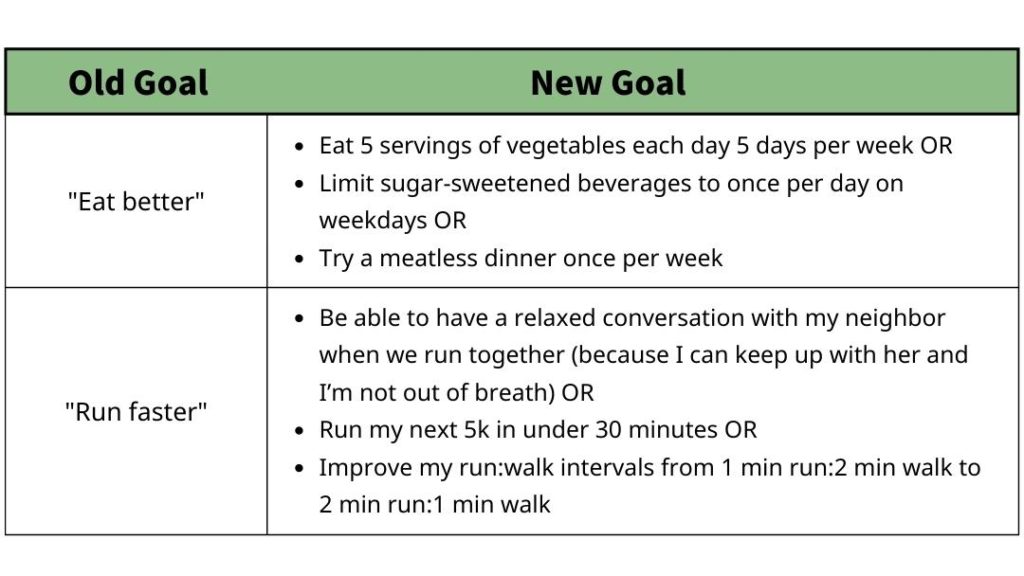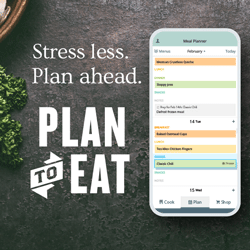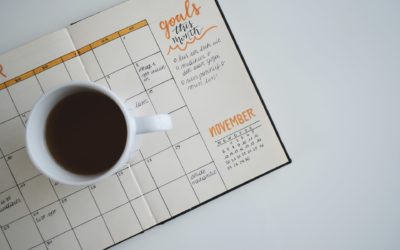If you want to live a healthier life, but you keep getting stuck in an endless cycle of trying -> failing -> quitting -> trying something else, then you are not alone. Changing our behaviors is hard, but you can break this cycle. Keep reading to learn some tips to make changes that last and improve your life and your health for the better, permanently.
(Pin this post to read later)

Step 1: Pick which type of change you would like to focus on
People often have more than one thing they would like to change about their lives. While it’s fantastic to be motivated to make several improvements, it can also derail your progress if you try to change too many things at once. Change takes planning, time, and energy. If we are overextended by trying to do a bunch of things simultaneously, we may not have the bandwidth to follow through with any of it.
That’s why I recommend trying to change just one thing at a time.
Attempting to overhaul your entire diet while simultaneously starting a vigorous exercise program is too much. Instead, decide whether you want to focus on diet OR exercise. Once you’ve chosen, make that one thing a priority. (By the way, that doesn’t mean you never do the other thing. It just means that you don’t do it right now.)
Step 2: Narrow your focus down even farther to one small change you’d like to make
Once you’ve chosen what larger area you’d like to focus on changing, pick one small, realistic thing to work on. In the diet overhaul example, this could be eating a vegetable at lunch, or leaving a little food on your plate if you tend to overeat. For the exercise example, if you are not exercising at all, then a reasonable step would be to walk for 10-15 minutes a day.
In fact, make the change so easy you can’t fail
An even better way to rack up wins is to make your target behavior so easy to do that you are at least 90% confident you can do it. I personally used this trick to establish a regular meditation practice that has been going strong for over two years.
Using the Calm app, I decided that I would meditate for at least 2 minutes per day. I had a goal of 10 minutes, but if I was tired or wasn’t feeling it, I would allow myself to just do 2 minutes. And you know what? That bar was so low, that I felt I could do it. And I did. Every single day!
Step 3: Drill down even farther and make your goal measurable
Many of us set goals that are difficult to measure. For instance, if your goal is to “eat better” or “run faster,” how do you know when you’ve accomplished those things? That’s why it’s important to get really specific about what you are trying to do.
Let me rephrase those two goals as an example:

I want you to notice a few things about these examples:
- For each of these rephrased goals, you can now answer “Did I accomplish my goal?” with a simple yes or no. Either you can run a 5k in under 30 minutes or you can’t.
- For the goals in the “eat better” category, I got specific about how many days per week to do the target behavior. That’s because it’s almost impossible to “be perfect” with our eating and hit the target every single day. This gives you the ability to relax and not worry about your goal at least a few days per week.
- I listed multiple examples for each goal in the “new goal” column. That’s because the original goals weren’t very specific, and there’s a lot of ways they could be interpreted. That’s another reason to really hone in on what you are trying to accomplish. “Eat better” and “run faster” can mean very different things to different people. Choose what works for you.
Step 4: Measure your accomplishments by tracking your target behavior
Once you’ve set your measurable goal, keep track of your progress as you work towards accomplishing it. This can be done in any number of ways; I suggest you pick whichever one you will consistently use. If you’re a technology person, use the Notes function on your phone, or try an app like Habitica. If you’re a paper-and-pencil person, check out Etsy for cute habit-tracker printables. You can also purchase a Happy Planner habit-tracker, or design a bullet-journal page that makes you feel inspired. It doesn’t matter how you track. It’s the act of tracking itself that helps.
In addition to informing us of how successful we are, keeping track of our progress also makes us more aware of our behavior and can clue us in to issues that are impeding our progress. It can also help us to see that we are, in fact, doing what we set out to do. (Sometimes our negative thought patterns can tell us otherwise).
Read more here:
4 reasons to track goal progress when changing behaviors
8 simple (and fun!) goal tracking ideas to maximize success
Step 5: Proactively deal with setbacks (they are inevitable!)
Behavior change is not a linear process. You may make improvements to your eating habits, but then Christmas rolls around and you are tempted by all the goodies at holiday parties and you overeat. It’s okay. It’s normal.
Having lapses or making slip-ups when you are trying to change a behavior is not failure. It’s just part of the process. Realizing this is an important step to getting back on the horse.
Anticipate difficult situations and make a plan for them
Now that you know that slip-ups are normal, you can plan for them!
All you need to do is think about situations or events that have historically been challenging to navigate. Then make a plan for how to tackle them before they actually happen.
For instance, if you resort to emotional eating when your mother-in-law is in town, or if you skip workouts when you are on your period, think about what you can do to work around that. Maybe you give yourself a time-out each day your mother-in-law is visiting. Leave the house and do something fun! Maybe you decide a 10 minute walk or an easy stretch is enough exercise to feel like you’re not giving up when you’re on your period. You get to decide what feels right for you.
Step 6: Find encouragement and support – from yourself and others
Find your “why”
I hear this statement again and again in various webinars I attend and books I read: if you want to be successful, find your “why.” The thinking behind this is that persevering at difficult tasks is, well, difficult. In those moments when you feel like giving up, it is helpful to remember your purpose for trying in the first place. Thinking about and writing down your “why” statement is a way to support yourself in making changes that last.
Enlist support or find a group of like-minded individuals who have similar goals
Just like having a workout buddy helps you to stick to an exercise routine, having an accountability buddy can help you stay on track with other types of changes. Here are some examples:
- If you’re a social person who also likes to exercise, consider joining a running group or do a group exercise class at a gym.
- If you have a friend who wants to make similar changes as you, then set up a weekly time to chat, set goals, and discuss what worked and what didn’t work that week.
- If you like having a plan laid out for you to follow, consider hiring a health coach, a dietitian, or a personal trainer.
Don’t forget to reward yourself for a job well done
Make sure to reward yourself when you accomplish your stated goals. In the past, I have bought myself a new pair of shoes when I exercised at least 4 times a week for a month. Some other motivating rewards I’ve used are purchasing an inexpensive ebook or an mp3 or treating myself to new workout clothes. Writing down your rewards in advance can also be a tool to help motivate you to stick with a new behavior.
Remember that “maintenance” is a form of success, too
Sometimes we are so focused on improving and changing that we neglect to realize that just staying where we’re at is good enough. For example, if you have a history of steady weight gain, but you’ve made some healthy changes and your weight is now stable, that is success. If you used to hate exercise but you now take a walk with a friend twice a week, almost every week, and you enjoy it, that is success. Don’t take those new behaviors for granted; you worked hard to earn them.
Before you start to change anything: read this first
I hope that you find all of the above advice useful in your quest to make lasting changes. However, there is one thing you should do before you start any of this: take a moment to evaluate if you are truly ready, willing and able to make a change right now.
To give an example from my personal life, I would love to start running again and train for a longer distance race. However, with a little introspection, this is not a good idea. Covid seems interminable, my kids’ school schedule is shortened, and my younger son wakes me up multiple times every night. I am kind of exhausted and burned-out.
So even though I would love to run a half marathon again someday, now is not the optimal time to try and do that.
Instead, I am putting my focus on maintaining my current healthy habits (like daily meditation) and attempting to do something easy: remembering to put on sunscreen every morning. It’s not glamorous or exciting, but it’s manageable and I can be successful at it.
If you’re not sure where you stand when it comes to making changes, check out this quick quiz from the American Council on Exercise (ACE) website.
In summary
I hope this post has provided you with some ideas to make lasting positive changes to your life. Remember that you are in good company. There are a lot of people who want to live a healthier lifestyle, and it is completely normal to have setbacks and need to try again. Don’t forget to give yourself some of the compassion that you show to others.







0 Comments